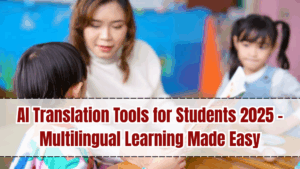Education in today’s interconnected world requires access to resources across multiple languages. However, language barriers often prevent students from learning effectively, especially in regions where English or other global languages are not widely spoken. In 2025, AI Translation Tools for Students are transforming classrooms and online learning by making content accessible in multiple languages instantly. These tools are bridging gaps in education, ensuring that every student, regardless of their native tongue, can access global knowledge.

What are AI Translation Tools?
AI Translation Tools are advanced platforms powered by artificial intelligence that convert text, speech, or entire lessons from one language to another in real time. Unlike traditional dictionaries or manual translation, these tools are context-aware, meaning they understand grammar, tone, and subject matter to provide accurate results.
Key capabilities include:
-
Real-time text translation for assignments and study material.
-
Voice-to-text tools that transcribe and translate lectures instantly.
-
Multilingual chatbots for peer and teacher interactions.
-
Offline translation apps for regions with limited internet.
-
AI-driven subtitles for online video learning platforms.
Why They Matter in 2025
The importance of AI Translation Tools for Students 2025 lies in their role in democratizing education. Many online courses, research papers, and digital libraries are still available only in English or a few global languages. With AI translation, students in rural India, Africa, or Latin America can learn from the same sources as students in developed countries. This levels the playing field, promotes inclusivity, and supports multilingual education policies worldwide.
Benefits of AI Translation Tools
AI-powered translation solutions are driving major educational benefits:
-
Accessibility: Students can study in their native language.
-
Improved Learning: Understanding complex topics becomes easier when explained in familiar terms.
-
Global Collaboration: Enables cross-border academic projects without language barriers.
-
Confidence Building: Students engage more actively when they understand course material.
-
Equal Opportunities: Helps bridge the digital divide in multilingual societies.
These tools are empowering learners to think globally while learning locally.
Role of Technology
Technology ensures that translation tools in 2025 are far more advanced than their earlier versions. Natural Language Processing (NLP) enables context-sensitive translations, while machine learning algorithms keep improving accuracy with usage. Speech recognition software provides real-time lecture translations, and AI-generated subtitles make video-based education accessible in any language. Cloud platforms store multilingual databases, ensuring even rare regional dialects are supported.
Government and Industry Initiatives
Governments and EdTech companies are heavily promoting translation tools to make education inclusive. Many universities now offer multilingual e-learning platforms integrated with AI translators. In regions with multiple local languages, governments are encouraging schools to adopt AI-based translation apps to ensure no student is left behind. Global tech firms are also investing in AI research to improve translations for educational purposes, expanding the reach of online courses and certifications.
Future of AI Translation in Education
The future of AI translation tools will go beyond simple word conversion. By 2030, AI systems will provide personalized learning translations adapted to student levels. Virtual classrooms will allow students from different countries to collaborate in real time with seamless translation. AI will also support regional language preservation, ensuring cultural diversity is maintained in the digital era. These developments will make learning truly borderless.
Conclusion
AI Translation Tools for Students 2025 are revolutionizing the way knowledge is shared and consumed. By breaking language barriers, they ensure every learner has access to the same global resources regardless of geography or background. With governments, EdTech platforms, and AI innovators working together, the dream of truly inclusive and multilingual education is becoming a reality. In the years ahead, these tools will not just support learning — they will redefine it.
FAQs
What are AI Translation Tools for Students 2025?
They are AI-powered platforms that provide real-time translation of text, speech, and educational material into multiple languages.
How do they benefit students?
They make education accessible in native languages, improve comprehension, and promote confidence in learning.
Do these tools work offline?
Yes, many AI translation apps now offer offline modes for areas with limited internet connectivity.
Are AI translations accurate for complex subjects?
Modern AI tools use NLP and machine learning to ensure context-based accuracy, even in technical or academic topics.
What is the future of AI translation in education?
Future tools will offer personalized translations, enable global classrooms, and help preserve regional languages.
Click here to know more.
